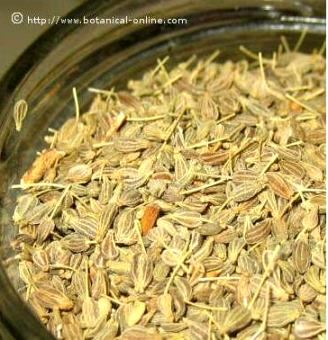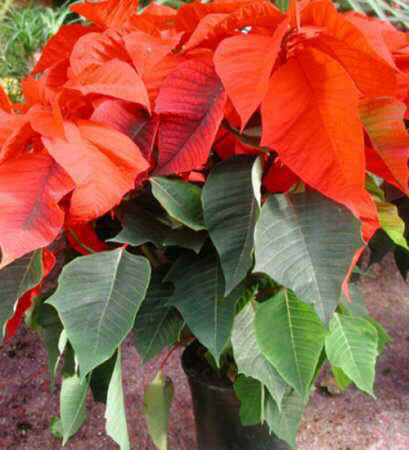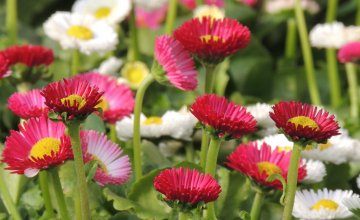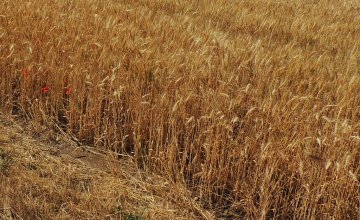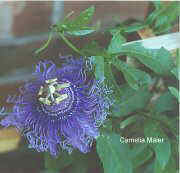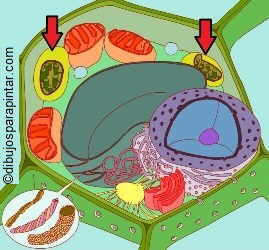Contents
Medicinal uses of saffron
BENEFITS OF SAFFRON
Saffron is a very old and expensive medicinal remedy, which is only destined for those who can allow it.
The remedy is on the stigmas of the saffron flower (Crocus sativus), which are reddish-orange and possesses a strong, pungent flavor. For its coloring and aromatic power, saffron is also used as an aromatic spice in culinary preparations.
* Caution: You must purchase properly packed saffron to avoid buying adulterated product.
| Read this before using it !Saffron should be taken with caution so as not to exceed the therapeutic dose. This type of supplement can cause tolerable side effects (see listing below), and high doses may have irritating effect on the uterine muscles. It is also contraindicated in women suffering menorrhagia, because it could cause bleeding outside the menstrual cycle. Saffron was used clandestinely in antiquity as an abortifacient plant. The prestigious botanist Pio Font Quer described in his work that saffron, taken in sufficient quantity, may cause abortion. However, this remedy is NOT recommended for this purpose because high doses of saffron can cause the death of the mother. Read the Toxicity of Crocus. Never exceeded 1.5 g. saffron daily |
MEDICINAL PROPERTIES OF SAFFRON
What is saffron used for?
– For digestion: the use of saffron as a spice in the kitchen is a sample of popular wisdom in the use of herbal medicine. Saffron, for its aromatic and bitter components (picrocrocin), stimulates the digestive system and increases salivary and gastric secretions so it is an excellent appetizer.
Saffron also contains crocetin, choleretic component that stimulates the production of bile and thins, helping the digestive process and help prevent stones in the gallbladder. In addition, scientific studies have shown beneficial properties of saffron to the liver. The saffron extract protects liver lesions produced by aflatoxins which we can ingest from badly stored food.
* More information about components of saffron
Saffron is indicated for those who have not appetite as a result of indigestion or dyspepsia (Lack of gastric juices) but,we we can as well add it in any healthy diet to promote digestion of food.
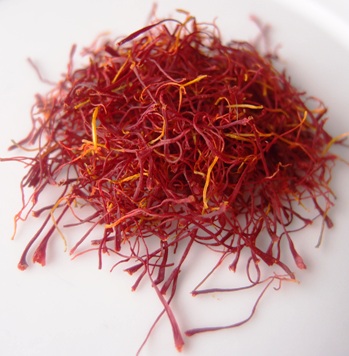
Dried stigmas of saffron, as sold as a spice
– Menstrual pain: Saffron has a very important role as an emmenagogue (That’s to say to promote and regulate menstruation) and also as antispasmodic to treat premenstrual symptoms and dysmenorrhea. It has been shown that saffron favors the menstrual cycle in women, prevents uterine cramping and benefits menstrual flow .
(Saffron powder or capsules: 500mg, 2 times a day for menstrual symptoms Decoction:.. 0.5 g of saffron in 200ml of hot water or milk. Extract:.. 15mg daily.)
– Antioxidant: crocin, saffron main component is a powerful natural antioxidant. This substance “hijacks ” free radicals, thus delaying the aging of cells in the body and improving overall health. Scientific studies have shown that this antioxidant is effective even when used in low concentrations below 40ppm.
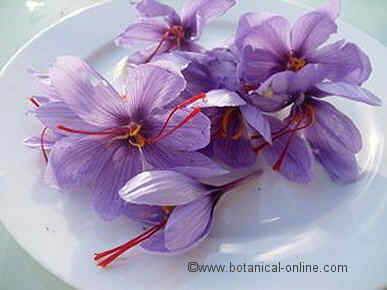
Saffron flowers. Note the reddish stigmas protruding
– For memory: saffron extract, containing crocin and crocetin, has shown to improve memory and cognitive skills or favour learning in numerous scientific studies. It also suggests that saffron is a good dietary supplement for people suffering from stress.
The antioxidant power of this aromatic spice, helps protect the brain from stress, thus improving memory. It is being studied its protective effect on degenerative diseases like Parkinson’s, Alzheimer’s and memory loss. (Decoction :.. 0.5 g of saffron 200ml cold water. Cook until boiling, remove from heat, let stand for 5 minutes, strain and serve. Take 1-2 cups a day. Do not exceed 1.5 g… saffron day.)
– Improves vision: the vision is an organ directly related to the nervous system. Since the components of saffron have shown antioxidant properties to brain cells, supplementation with this spice also improves eye health, as demonstrated by scientific studies. Safranal, aromatic component of saffron, slows down the degeneration of photoreceptor cells in the eye, improves the function of the retina and protects eye blood vessels.
– Stimulant: Dioscorides, the father of medicine, considered saffron as an excellent stimulant. Andrés Laguna, also cited it as a stimulant remedy in his book: ” Saffron stimulates (…) Its average use rejoices you, encourages eating and gives color to your face, but taking too much makes you sad, delivers boredom and spills all over your body some very strange yellowness that disrupts your mind and causes headaches”
– Cardiovascular disease: saffron is a very aromatic spice rich in antioxidants, which acts as a preventive of cardiovascular disease. Since ancient times, it has been considered a friendly remedy, which fortifies the heart. As stated by the medical and botanical scholar Andrés Laguna ” As vigorous and effective saffron is that, applied in the palm of your hand, suddenly penetrates into the heart.”
Indeed, crocetin, the red saffron pigment, can help reduce cholesterol, as demonstrated in scientific studies. This carotenoid may have beneficial applications for arteriosclerosis, and it has been observed that this type of flavonoid nutrition favours small blood capillaries or terminations, improving atherosclerosis and arthritis. (30 mg. Daily extract of saffron. Also as a spice added to food).
| It has been found that, in regions where saffron is consumed daily,,there is less incidence of cardiovascular disease . |
– Diabetes: Because of its high antioxidant power and wealth in carotenoids, saffron can be a beneficial supplement for people with diabetes. Saffron extract protects these patients against diabetic neuropathy (damage to nerves due to the excess of blood sugar), and prevents vision problems. (30 mg. Daily extract of saffron.)
– Anticancer: Saffron contains carotenoids and flavonoids, which help to slow tumor growth, lengthening life expectancy. It has also been observed that saffron may reduce renal damage caused by certain medications. However, this has not been tested in humans.
– Antidepressant : saffron has also been studied for its antidepressant properties. Double-blind studies have found that 30mg. saffron extract daily for 6-8 weeks is as effective as fluoxetine (medicine for depression), in cases of mild and moderate depression. (30 mg. Daily extract of saffron.).
– Sedative: saffron contains sedative aromatic substances that help fight nervousness and anxiety. Dioscorides prescribed ” ointment of Crocin ” as a remedy for insomnia. This name comes from the root Crocus. It is said to be so effective as a sleeping pill.
HOW TO PREPARE OINTMENT OF CROCIN
Ingredients:
– Saffron stigmas
– Olive oil
– Myrrh
Preparation:
– Macerate saffron stigmas in olive oil for five days
– Strain
– Dilute the strained liquid in another equal part of olive oil.
– Add Myrrh
– Macerate for 3 more days
How to apply
– Apply it on the skin
– Diaphoretic: saffron is diaphoretic, so used in febrile conditions to promote sweating.
External use medicinal preparations with saffron
– Toothache: In Spain ethnobotany, concentrated infusions of saffron were prepared to apply externally against toothache or teething problems of children. Its components are used in mouthwash formulas to prevent mouth sores. (Prepare a decoction with 1g. Saffron, gum rinse and spit for a few minutes, up to 2 times a day. Do not ingest.).
Saffron posology
– Decoction: 0.5 g. saffron with 200ml. of cold water. Cook until boiling, remove from heat, let stand for 5 minutes, strain and serve. Take between 125ml. and 300ml. Total daily (1-2 cups a day). Do Not exceed 1.5 g. daily.
– Dust: 3g. saffron before meals as an appetizer and eupectic. Take between 0.5 and 1.5 g. daily to promote menstruation.
– Tincture: saffron dip in alcohol and water. It can be purchased in department stores. Taken in doses of 2 to 5g. daily.
Caution
– Use patterned strictly dose. It is considered that daily doses higher than 1.5 g of saffron may cause side effects.
– Do not prolong treatment with saffron over 6 weeks.
– Saffron has a number of important contraindications. Read them.
– Doses above 1.5 g. saffron can be abortive and dangerous to the health of the mother.
– Greater than 10g dose. saffron can be fatal.
– This species of crocus must be properly packaged by a reputable dealer, to ensure proper handling and authenticity
![]() … Previous reading: Saffron plant //Continue reading… Saffron as an edible spice
… Previous reading: Saffron plant //Continue reading… Saffron as an edible spice

